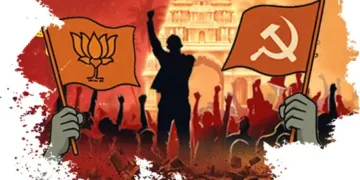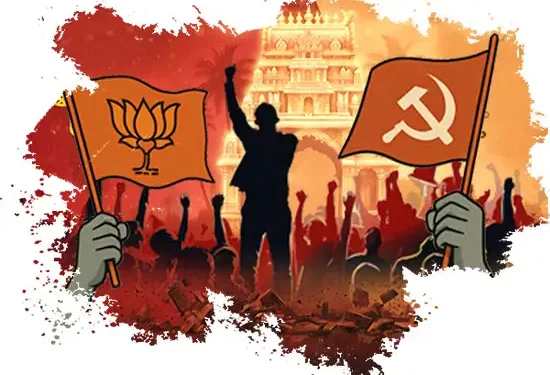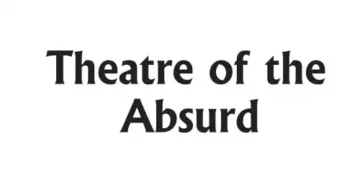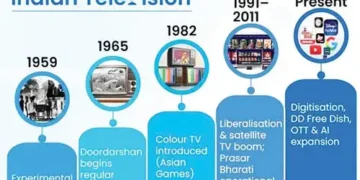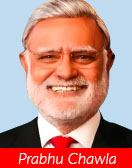 KERALA, long hailed as a cradle of social reform and progressive politics, is undergoing a profound political shift. The state that once stood as India’s ideological outpost of communism and secular reason is now grappling with the growing pull of cultural nationalism. The bipolar rhythm that defined Kerala’s democracy for half a century – the predictable alternation of power between the Left Democratic Front and the Congress-led United Democratic Front – is weakening. In its place, a third pole is taking shape, as the Bharatiya Janata Party and the Sangh parivar make a visible impact on social and political events in a state once thought immune to their influence.
KERALA, long hailed as a cradle of social reform and progressive politics, is undergoing a profound political shift. The state that once stood as India’s ideological outpost of communism and secular reason is now grappling with the growing pull of cultural nationalism. The bipolar rhythm that defined Kerala’s democracy for half a century – the predictable alternation of power between the Left Democratic Front and the Congress-led United Democratic Front – is weakening. In its place, a third pole is taking shape, as the Bharatiya Janata Party and the Sangh parivar make a visible impact on social and political events in a state once thought immune to their influence.
The upcoming 2026 Assembly election has transformed the state into a battleground of ideologies, identities, and power. The LDF, led by Chief Minister Pinarayi Vijayan, and the Congressled UDF under state Congress president K Sudhakaran are scrambling to hold on to a political landscape that is shifting beneath their feet. For decades, the state was a bastion of communism and secular orthodoxy. Today, the BJP, under Prime Minister Narendra Modi and Union Home Minister Amit Shah, along with the Sangh parivar, is rewriting the rules of engagement, injecting nationalism, cultural pride, and assertive ideology into Kerala’s politics.
Every controversy, every moral debate, and every community mobilisation is now viewed through the lens of the election, making 2026 not just a vote but a referendum on the state’s future ideological identity. Kerala’s story, long written in the colour red,is slowly being rewritten in shades of saffron.
THE pre-election period has already seen a surge in controversies that highlight the Left’s ideological vulnerabilities. The LDF revived an old allegation against RSS leader K Valsan Thillankeri, accusing him of sexually exploiting a man who later died by suicide. The case, dormant for nearly a decade, resurfaced at a time when the Sangh’s influence was visibly rising, signalling how the Left is willing to weaponise moral controversies for electoral advantage.
At the same time, Kerala’s Minister for General Education V Sivankutty, of the CPI (M), publicly supported a Muslim student’s right to wear the hijab in school, presenting it as a matter of personal freedom. BJP state President K Surendran criticised this as blatant appeasement. Interestingly, Congress spokesperson Ramesh Chennithala, in a rare alignment, lent tacit support to the RSS cadre under scrutiny.
Nuns’ detention
Earlier in the year, the detention of Catholic nuns in BJP-ruled Chhattisgarh was cited by the Left and the Congress to attack the BJP, while the saffron camp framed it as evidence of the opposition’s selective outrage. These flashpoints are not isolated. They reflect heightened pre-election political environment, where identity, morality, and religion have overtaken governance as the primary axes of debate.
The hijab debate and revival of old allegations highlight the Left’s current ideological fragility. By endorsing selective religious claims, Sivankutty and his party seek minority votes. Yet, in doing so, they dilute the Left’s secular core. The BJP seized on these moments to expose the Left’s hypocrisy, showing that a party that once criticised appeasement now practices it openly.
The Congress, still searching for a clear stance, has oscillated opportunistically between defending the Left and criticising the BJP. Kerala’s political discourse, once grounded in rationalism and welfare, is now dominated by pre-election posturing, moral ambiguity, and identity politics.
The BJP’s breakthrough in the 2024 Lok Sabha elections has further intensified pre-election dynamics. For the first time, the party won a parliamentary seat in Kerala when actor-turned-politician Suresh Gopi captured Thrissur, ending decades of marginalisation. The party’s statewide vote share reached around 16 per cent, getting about 25 per cent or more in constituencies such as Thiruvananthapuram, Palakkad, and Thrissur.
Formidable barrier
However, Kerala’s demographic makeup alone presents a formidable barrier to the BJP’s ambitions. According to the 2011 Census, Hindus account for 54.73 per cent of the state’s population, Muslims 36.56 per cent, and Christians 18.48 percent. Thus, Muslims and Christians together constitute about 45 per cent Kerala’s population. They are large, well-organised, and entrenched in social institutions such as mosques, churches, community bodies, and minority political formations.
The BJP’s vote share may be rising, but remains far behind the dominant fronts’. The RSS can probably alter the one-sided narrative. But it would find it difficult to acquire political power even in the long run. This is not just a political pivot; it is Kerala’s karmic reckoning where conviction meets culture, and the story of God’s own country is rewritten by its own children.
Nevertheless, sociologically, the changes are visible in traditional community alignments. The Ezhava community, represented by the Sree Narayana Dharma Paripalana Yogam under Vellappally Natesan, has increasingly aligned with saffron initiatives. The Nair Service Society led by G Sukumaran Nair has signalled openness to cultural nationalism on issues such as Sabarimala.
Even younger Christian leaders in central Kerala are reassessing their political affiliations. The electorate is no longer bound by conventional ideological loyalties, and the space once dominated by the Left and Congress is now contested by an ideology rooted in heritage, cultural cohesion, and principled governance. In addition, the Left’s fatigue after consecutive terms in power is evident. Vijayan and his ministers spend more energy defending controversies than shaping policy. Governance challenges, including rising inflation, youth unemployment, and declining remittances from the Gulf have weakened the Left’s moral authority.
Complex environment
Kerala’s political environment remains complex. Literacy, civil society activism, and a politically aware electorate provide resilience against polarisation. The state’s Muslim and Christian minorities together ensure no ideology can dominate purely through majoritarian appeal. Yet, the Sangh parivar’s expansion and the BJP’s strategic outreach have created a credible, ideologically coherent alternative capable of challenging the Left and Congress on multiple fronts. The upcoming Assembly election is poised to be the most consequential since 1957, when EMS Namboodiripad led the world’s first democratically elected communist government.
Two dynamics underscore the emerging future. First, younger voters, disillusioned with ideological stagnation and political infighting, are more receptive to development and national renewal than in class struggle or historical orthodoxy. Second, the Left’s increasing reliance on selective minority appeasement has alienated traditional Hindu support bases, creating a structural opening for saffron consolidation. Together, these factors signal a lasting reconfiguration of Kerala’s political, social, and cultural map.
Inflection point
As the 2026 Assembly election approaches, Kerala stands at a historic inflection point. Citizens are no longer simply choosing between the Left and the Congress. They are deciding the ideological future of a state long known for social progress. God’s own country, once the stronghold of communism and liberalism, is now gravitating slowly toward a nationalist awakening. Governance is being measured by principle rather than appeasement, identity rather than factional loyalty.
In this transition from Marx to mandir, the greatest irony is that the Left, in claiming to defend secularism, has become the practitioner of appeasement, inadvertently paving the way for an alternative nationalist revival that is perceived to align with the values, culture, and aspirations of those sections of Malayalis it once sought to marginalise.
